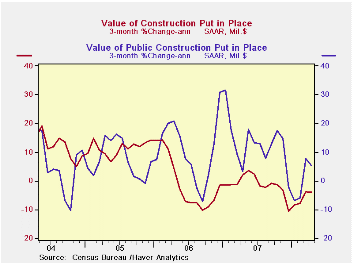 Global| Jun 02 2008
Global| Jun 02 2008U.S. Construction Spending Down Again
by:Tom Moeller
|in:Economy in Brief
Summary
The value of construction put in place fell for the seventh consecutive month in April. The 0.4% decline was about as-expected and the March decline of 0.6% was half that reported initially. Nevertheless, the value of total [...]

The value of construction put in place fell for the seventh consecutive month in April. The 0.4% decline was about as-expected and the March decline of 0.6% was half that reported initially. Nevertheless, the value of total construction was down 8.6% since its peak in early 2006.
A 2.3% decline in the April value of residential building activity led last month's decline in the total, and since its peak it has fallen by more than one-third. The 37.4% decline was paced by lower building of single family units; down 4.4% in April and by 3.0% to 5.4% in each of the prior eight months. Building activity on multi-family units increased 0.4% (-12.5% y/y) for the second straight month while spending on improvements fell 0.5% (+7.5% y/y).
During the last twenty years there has been an 84% correlation between the q/q change in the value of residential building and its contribution to growth in real GDP.
The value of nonresidential building activity surged again for the third straight month. The 1.6% increase was led by a 7.6% (45.4% y/y) jump in lodging and a 1.0% (19.4% y/y) increase in the education category. Growth in office building remained firm though it posted only a 0.5% (15.0% y/y) increase during April. Growth in multi-retail building eased. A 2.1% gain during April failed to make up the declines during the prior few months and spending was down 4.1% y/y.
Public construction slipped 0.3% after a 1.0% March surge. Public sector nonresidential building slipped 0.5% but it still was up 7.0% y/y. The value of construction spending on highways & streets ticked up 0.1% (5.2% y/y) after strong gains during the prior two months. (The value of construction on highways & streets is roughly one third of the value of total public construction spending.) Building activity of educational facilities rose 7.3% from a year earlier and nonresidential office building surged 26.4% y/y.
The more detailed categories of construction represent the Census Bureau’s reclassification of construction activity into end-use groups. Finer detail is available for many of the categories; for instance, commercial construction is shown for automotive sales and parking facilities, drugstores, building supply stores, and both commercial warehouses and mini-storage facilities. Note that start dates vary for some seasonally adjusted line items in 2000 and 2002 and that constant-dollar data are no longer computed.
| Construction | April | March | Y/Y | 2007 | 2006 | 2005 |
|---|---|---|---|---|---|---|
| Total | -0.4% | -0.6% | -3.9% | -2.7% | 5.6% | 10.7% |
| Private | -0.5% | -1.1% | -7.2% | -6.8% | 4.7% | 12.0% |
| Residential | -2.3% | -3.0% | -21.0% | -18.1% | 0.5% | 13.7% |
| Nonresidential | 1.6% | 1.2% | 15.4% | 18.0% | 15.2% | 7.8% |
| Public | -0.3% | 1.0% | 6.8% | 12.2% | 9.2% | 6.2% |
Tom Moeller
AuthorMore in Author Profile »Prior to joining Haver Analytics in 2000, Mr. Moeller worked as the Economist at Chancellor Capital Management from 1985 to 1999. There, he developed comprehensive economic forecasts and interpreted economic data for equity and fixed income portfolio managers. Also at Chancellor, Mr. Moeller worked as an equity analyst and was responsible for researching and rating companies in the economically sensitive automobile and housing industries for investment in Chancellor’s equity portfolio. Prior to joining Chancellor, Mr. Moeller was an Economist at Citibank from 1979 to 1984. He also analyzed pricing behavior in the metals industry for the Council on Wage and Price Stability in Washington, D.C. In 1999, Mr. Moeller received the award for most accurate forecast from the Forecasters' Club of New York. From 1990 to 1992 he was President of the New York Association for Business Economists. Mr. Moeller earned an M.B.A. in Finance from Fordham University, where he graduated in 1987. He holds a Bachelor of Arts in Economics from George Washington University.






